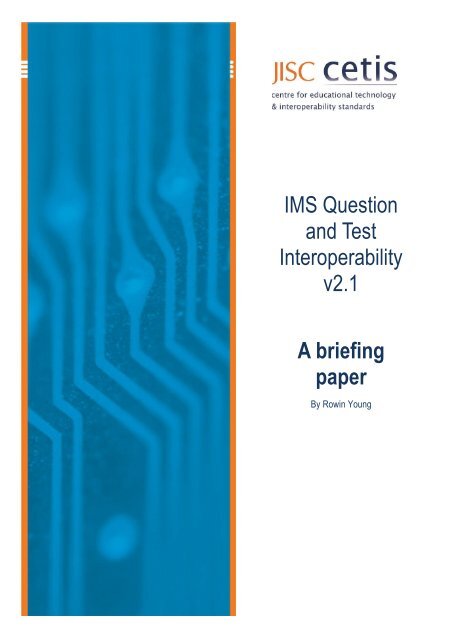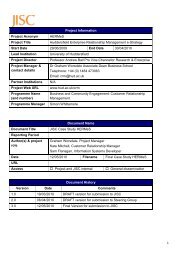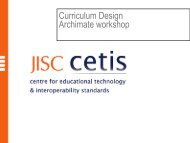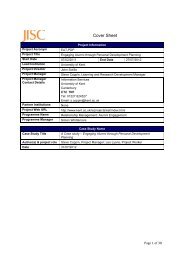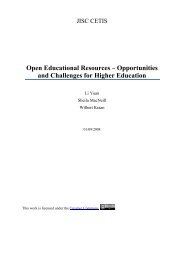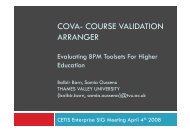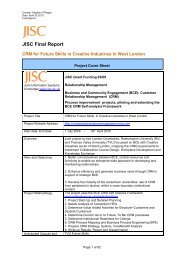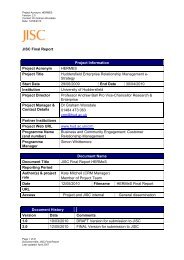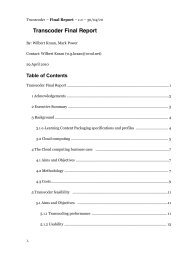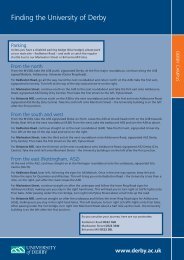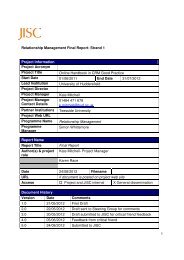IMS Question and Test Interoperability v2.1 A briefing paper
IMS Question and Test Interoperability v2.1 A briefing paper
IMS Question and Test Interoperability v2.1 A briefing paper
Create successful ePaper yourself
Turn your PDF publications into a flip-book with our unique Google optimized e-Paper software.
<strong>IMS</strong> <strong>Question</strong><br />
<strong>and</strong> <strong>Test</strong><br />
<strong>Interoperability</strong><br />
<strong>v2.1</strong><br />
A <strong>briefing</strong><br />
<strong>paper</strong><br />
By Rowin Young
<strong>IMS</strong> <strong>Question</strong> <strong>and</strong> <strong>Test</strong> <strong>Interoperability</strong> <strong>v2.1</strong><br />
<strong>IMS</strong> <strong>Question</strong> <strong>and</strong> <strong>Test</strong> <strong>Interoperability</strong><br />
<strong>v2.1</strong><br />
By Rowin Young<br />
Abstract<br />
Providing a decade of interoperable assessment, <strong>IMS</strong> <strong>Question</strong> <strong>and</strong> <strong>Test</strong> <strong>Interoperability</strong> is a widely used specification for<br />
managing <strong>and</strong> sharing assessment material. With the release of the final version of QTI <strong>v2.1</strong> imminent, this <strong>paper</strong> provides<br />
an overview of the specification, outlining some of the key features of QTI <strong>v2.1</strong> <strong>and</strong> its value for developers <strong>and</strong> educators.<br />
The intended audience for this <strong>paper</strong> is managers, learning technologists <strong>and</strong> developers interested in online <strong>and</strong> electronic<br />
assessment <strong>and</strong> new to QTI.<br />
Please note: the final version of QTI <strong>v2.1</strong> is due for release some time in 2011. This document is therefore based on the<br />
latest public draft version available, which is likely to be very close to the final release version. An updated version of this<br />
<strong>paper</strong> will be released on the CETIS website with the release of the specification.<br />
Keywords: assessment, QTI, specifications<br />
1 Introduction<br />
One of the earliest of the <strong>IMS</strong> specifications, QTI v1 offered a st<strong>and</strong>ardised way of representing assessment material that<br />
enabled the exchange of content between systems <strong>and</strong> organisations <strong>and</strong> promised greater longevity <strong>and</strong> permanence of<br />
content that was formerly at risk of being locked inside proprietary formats.<br />
The release of QTI <strong>v2.1</strong> represents a major l<strong>and</strong>mark in the history of the specification. Combining significant revisions fro m<br />
v1 identified after extensive real-world use <strong>and</strong> alterations to bring it more closely into line with more recent <strong>IMS</strong><br />
specifications <strong>and</strong> policy, 2.1 offers a much more useable <strong>and</strong> pragmatic specification.<br />
2 What is <strong>IMS</strong> <strong>Question</strong> <strong>and</strong> <strong>Test</strong> <strong>Interoperability</strong>?<br />
<strong>IMS</strong> <strong>Question</strong> <strong>and</strong> <strong>Test</strong> <strong>Interoperability</strong> (QTI) is a technical specification designed to make it easier to transfer assessment<br />
information between different compliant systems. This information can be both assessment content itself, <strong>and</strong> related<br />
information such as scores, outcomes <strong>and</strong> grades, <strong>and</strong> associated metadata.<br />
QTI uses extensible markup language (XML) tags to record information about assessments <strong>and</strong> c<strong>and</strong>idates. Each tag is<br />
defined within the QTI data model, offering a wide range of question types as well as the ability for developers to add<br />
bespoke items by extending the specification according to its guidance.<br />
2
<strong>IMS</strong> <strong>Question</strong> <strong>and</strong> <strong>Test</strong> <strong>Interoperability</strong> <strong>v2.1</strong><br />
Within QTI, assessment content is separated into individual items (an item is a question together with related information<br />
such as rubric, scoring instructions, layout, hints <strong>and</strong> feedback) <strong>and</strong> assessments, which contain one or more items <strong>and</strong> may<br />
be organised into subsections. Metadata about the item or assessment is stored in a separate data file in a profile complying<br />
with IEEE LOM. Instructions on packaging this content in accordance with <strong>IMS</strong> Content Packaging are also provided.<br />
An assessment delivery system may be compliant with the specification either directly, by processing <strong>and</strong> running QTI files<br />
themselves, or indirectly, by supporting the translation of QTI into or out of a proprietary format.<br />
<strong>IMS</strong> Common Cartridge incorporates profiles of both <strong>IMS</strong> v1.2.1 <strong>and</strong> <strong>v2.1</strong>, enabling the use of interoperable assessment<br />
content within these more general content packages.<br />
3 History <strong>and</strong> present<br />
QTI v1.0 was released in May 2000, one of the very first <strong>IMS</strong> specifications to be produced. Although well received <strong>and</strong><br />
adopted by a number of developers, its position so early within the <strong>IMS</strong> specification development cycle meant that it<br />
gradually became out of step with the rest of <strong>IMS</strong>’s specifications that emerged, particularly with respect to metadata<br />
management <strong>and</strong> packaging.<br />
V2.0 was released in January 2005, offering a substantial <strong>and</strong> very timely revision of the specification, bringing it into lin e<br />
with the rest of the suite of <strong>IMS</strong> specifications. As 2.0 only covered the item level, <strong>and</strong> not the construction of ful l<br />
assessments or sections, work immediately began on <strong>v2.1</strong>. After a prolonged period of development <strong>and</strong> testing involving<br />
developers from a wide range of institutions <strong>and</strong> organisations worldwide, it underwent a public interoperability<br />
demonstration at the <strong>IMS</strong> Quarterly meeting in Koblenz, Germany, in Summer 2010 <strong>and</strong> was approved for final release, with<br />
some minor modifications, as a result. The final version is due for release at some point in 2011.<br />
4 Outline of the specification<br />
The QTI specification is comprised of nine documents:<br />
Overview: outlines the history of the specification <strong>and</strong> establishes the scope of this particular version, with illustrative<br />
use cases.<br />
Assessment <strong>Test</strong>, Section <strong>and</strong> Item Information Model: provides the abstract description of concepts, relationships<br />
<strong>and</strong> rules of QTI items, sections <strong>and</strong> tests.<br />
XML Binding: provides an XML Schema <strong>and</strong> optional DTD (document type definition) against which QTI must validate.<br />
Results Reporting: describes how results <strong>and</strong> outcomes information should be h<strong>and</strong>led <strong>and</strong> exchanged.<br />
Implementation Guide: provides examples of QTI <strong>v2.1</strong> as illustrative demonstrations of how the specification may (but<br />
not must) be implemented.<br />
Integration Guide: explains how QTI <strong>v2.1</strong> can be used with <strong>IMS</strong> Content Packaging, <strong>IMS</strong> Learning Design, <strong>IMS</strong><br />
Simple Sequencing <strong>and</strong> IEEE CMI (Data Model for Content Object Communication).<br />
Conformance Guide: provides profiles against which tool developers can measure the interoperability of their product.<br />
Meta-data <strong>and</strong> Usage Data: provides an extended application profile of IEEE LOM to enable the description <strong>and</strong><br />
discovery of assessment material.<br />
Migration Guide: offers detailed guidance on converting content from v1.x to <strong>v2.1</strong>.<br />
3
<strong>IMS</strong> <strong>Question</strong> <strong>and</strong> <strong>Test</strong> <strong>Interoperability</strong> <strong>v2.1</strong><br />
5 Motivations for use<br />
Deployment of assessment software or an assessment management system which supports interoperability st<strong>and</strong>ards has a<br />
number of advantages:<br />
Transferability of content between systems, allowing access to a much larger amount of potential content developed by<br />
subject experts in other institutions or by professional content vendors.<br />
Durability <strong>and</strong> longevity of content <strong>and</strong> results information through avoiding content lock-in when working with an<br />
assessment delivery, assessment management or content system vendor.<br />
Efficiency in the development process by avoiding ‘reinventing the wheel’.<br />
Engagement with a wide community of practice.<br />
Although QTI has been around for a decade, <strong>v2.1</strong> represents a significant new release <strong>and</strong> it will take time for there to be a<br />
wide range of implementations. However, there are already a number of both open source <strong>and</strong> commercial products<br />
available which have implemented the public draft, while integration with VLEs such as Moodle brings QTI to a significantly<br />
wider audience. Finally, a QTI migration tool is available which converts QTI 1.x content to v2.0 content packages which<br />
may then be imported by 2.1 systems. A list of available resources is located under ‘Further Reading’ below.<br />
6 Criticisms <strong>and</strong> concerns<br />
Some potential or former users of QTI have expressed reservations about the use of the specification, <strong>and</strong> may have<br />
encountered problems in developing or sharing content. It is important to recognise the limitations of the specification:<br />
specification development activity is almost invariably reactive, responding to developments in assessment practice <strong>and</strong><br />
codifying innovations developed by practitioners, rather than proactively developing new techniques. It is therefore<br />
inherently conservative, reflecting general practice rather than innovative outliers, <strong>and</strong> represents a convergence of divergent<br />
practices towards a single model. QTI v2.x overcomes this to some extent by providing guidance on how unique question<br />
types can be integrated in individual implementations of the specification.<br />
In addition, <strong>IMS</strong> do not currently have a testing process in place to evaluate vendors’ claims of conformance beyond the<br />
limited profiles of QTI contained within Common Cartridge <strong>and</strong> Basic Learning Tools <strong>Interoperability</strong>. However, this may<br />
change with the release of the final version <strong>and</strong> inclusion of QTI <strong>v2.1</strong> within the <strong>IMS</strong> Conformance Programme.<br />
The long development period of the specification <strong>and</strong> the gradual changes to it may mean that some formerly ‘compliant’<br />
systems are now less (or more) so. With the specification finally available in a fixed <strong>and</strong> approved form, more stable<br />
releases should become available that erase anomalies of interpretation.<br />
Nevertheless, given the financial <strong>and</strong> time cost of developing <strong>and</strong> quality assuring assessment materials, the benefit of doing<br />
so in an interoperable format is considerable, <strong>and</strong> QTI offers a very viable means of doing so.<br />
7 Further reading<br />
<strong>IMS</strong> <strong>Question</strong> <strong>and</strong> <strong>Test</strong> <strong>Interoperability</strong> http://www.imsglobal.org/question/index.html<br />
List of assessment tools, projects <strong>and</strong> resources http://wiki.cetis.ac.uk/Assessment_tools,_projects_<strong>and</strong>_resources<br />
Wikipedia QTI entry http://en.wikipedia.org/wiki/QTI<br />
CETIS Assessment topic page http://jisc.cetis.ac.uk/topic/assessment<br />
4
<strong>IMS</strong> <strong>Question</strong> <strong>and</strong> <strong>Test</strong> <strong>Interoperability</strong> <strong>v2.1</strong><br />
<strong>IMS</strong> QTI discussion forum http://www.imsglobal.org/community/forum/categories.cfm?catid=52<br />
About this White Paper<br />
Title: <strong>IMS</strong> <strong>Question</strong> <strong>and</strong> <strong>Test</strong> <strong>Interoperability</strong> <strong>v2.1</strong><br />
Authors: Rowin Young<br />
Date: February 2011<br />
URI:<br />
Text Copyright © 2011 University of Bolton; cover image courtesy of JISC<br />
This work is licensed under the Creative Commons Attribution 2.0 UK: Engl<strong>and</strong> & Wales Licence. To view a copy of this<br />
licence, visit http://creativecommons.org/licenses/by/2.0/uk/ or send a letter to Creative Commons, 171 Second Street,<br />
Suite 300, San Francisco, California 94105, USA.<br />
For more information on the JISC CETIS publication policy see http://wiki.cetis.ac.uk/JISC_CETIS_Publication_Policy<br />
About JISC CETIS<br />
JISC CETIS is an Innovation Support Centre for UK Higher <strong>and</strong> Post-16 Education sectors funded by the Joint Information<br />
Systems Committee (JISC), <strong>and</strong> managed by the University of Bolton. The Centre provides strategic advice to JISC,<br />
supports its development programmes, represents the sector on international st<strong>and</strong>ardisation bodies <strong>and</strong> works with the<br />
educational community to facilitate the use of st<strong>and</strong>ards-based e-learning.<br />
For more information visit our website: http://jisc.cetis.ac.uk/<br />
5


